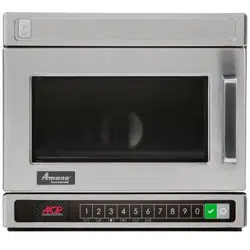Loading ...
Loading ...
Loading ...

©2020 ACP, Inc.
Cedar Rapids, IA 52404
Page 20 of 24
Part No. 20267401
Revised 9/2020
Cooking Guidelines (continued)
Manipulation of Foods
Sometimes recipes suggest manipulating or moving food
during cooking. There are several forms of manipulation:
Stirring is required less often in microwave cooking than
in conventional cooking. In conventional cooking, you use a
spoon to move food up from the bottom of a pan to evenly
distribute the heat. In microwave cooking, you still stir to
redistribute the heat within some foods, but you need to
stir from the outside of a dish toward the inside or center. If
a recipe states to stir once or twice during cooking, stir at
approximately even intervals. For example, in a 12-minute
cooking period, if a recipe states to stir twice, stir after 4
minutes of cooking and again, after 8 minutes of cooking.
However, it is not necessary to be precise. Stir only when
necessary. When using lower power levels or settings, less
stirring is required. Some examples of foods which may
require stirring are puddings, some casseroles, some sauces,
some soups, and some egg dishes. Some foods can’t be
stirred. These foods are rearranged or turned.
Some foods can’t be stirred and should be repositioned or
rearranged during cooking. Some examples include baked
potatoes, cupcakes (in custard cups), chicken pieces, and
others. Rearranging allows for more even cooking of foods.
Foods which are cooked, covered, or which are cooked using
lower power levels, usually require little rearranging.
There are actually two types of turning. Turning is done
when foods cannot be stirred. Foods which are cooked,
covered, or which are cooked at lower power levels usually
require little turning.
Turning foods over: Turning foods over is done to
distribute heat. Meat and poultry are two types of foods which
are sometimes “turned over.” Examples include roasts, turkeys
and whole chickens. Small meat items such as poultry pieces
may need to be turned over when in casseroles, or when in a
browning skillet.
Rotating or turning dishes: There are a few foods which
cannot be stirred, rearranged or turned over. Therefore, the
actual cooking dish is turned or rotated. A half-turn means
to grasp the dish and turn the portion of the dish that faces
the oven door around, until it faces the back of the oven.
Examples of foods which are sometimes turned or rotated
in a cooking dish include cakes, quiches, or soués. When
cooking foods at lower power levels or Settings, less turning of
the cooking dishes is required.
Microwave Utensils
Never use cooking containers or covers with any metal
content. This includes all metal and enameled metal-core
ware, foil, and metal-trimmed containers. Suitable cooking
containers include those made of paper products, glass,
china, cloth, and wicker baskets.
RECOMMENDED NOT RECOMMENDED
Glass/Ceramic Aluminum foil
Natural ber cloth Grocery bags
Non-recycled paper Recycled paper
Plastic Lead crystal
Wood Newspapers
Metal
Metallic trimmed china
UTENSIL CHECK TEST
Use the following test to check utensils for microwave
safeness.
1. Place glass measuring cup of water next to empty dish to be
tested in microwave oven.
2. Heat on full power for one minute.
3. Check temperature of dish and water.
• If dish remains cool and water is hot, dish is microwave
safe.
• If dish is slightly warm, use for short term cooking.
• If dish is hot and water is cool, do not use. Dish remains
cool if not absorbing microwaves and microwaves are
being absorbed by water. Dish becomes hot if absorbing
microwaves.
Cooking Hints
Cover foods for faster, more even cooking. Glass
lids, plastic wrap, plate covers or other paper products may
be used. Do not seal. Instead, allow for steam-venting at all
times.
Pierce pouches, plastic wrap covers and all foods
with a thin skin or membrane, such as potatoes, squash,
tomatoes, eggs, etc. This prevents an eruption in the oven and
allows for expansion and/or the escape of steam.
Foods should be carefully plated. For best results,
arrange food such as vegetables or casserole-type items
evenly around the edge of the plate with slightly less depth
in the center. The edges of food items should not overlap or
overhang the rim of the container. Cover meats with gravy or
au jus and moisten all dry foods other than bread or pastry
items.
Do not stack food or plated dishes in your oven.
Instead, when cooking more than one serving or platters, all
plates should be placed at the same level in the oven, with
space between all containers.
Loading ...
Loading ...
Loading ...
